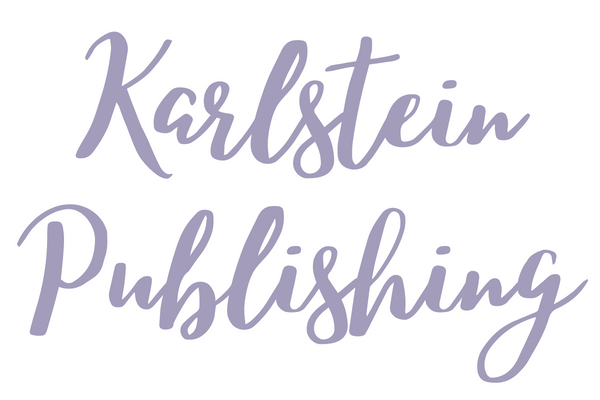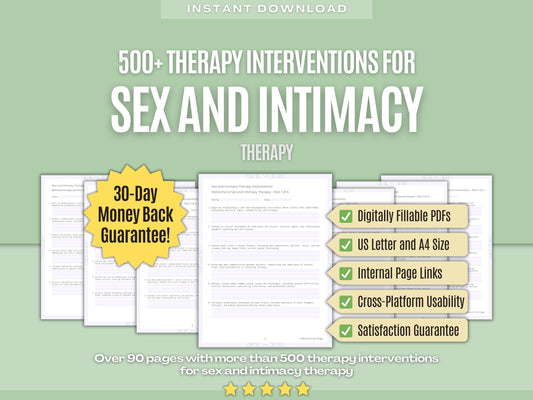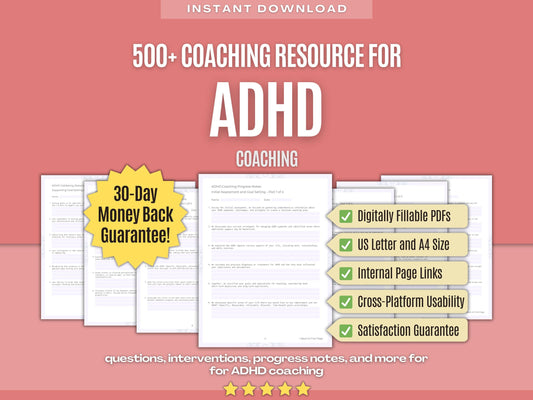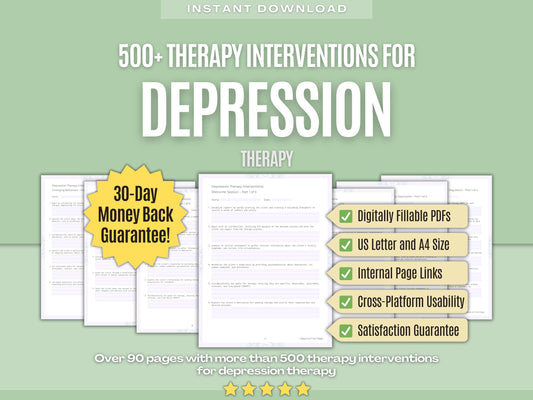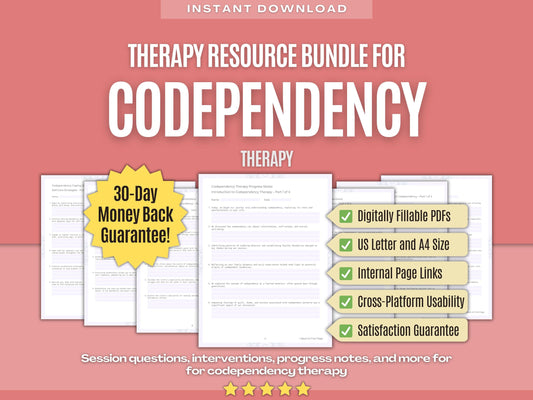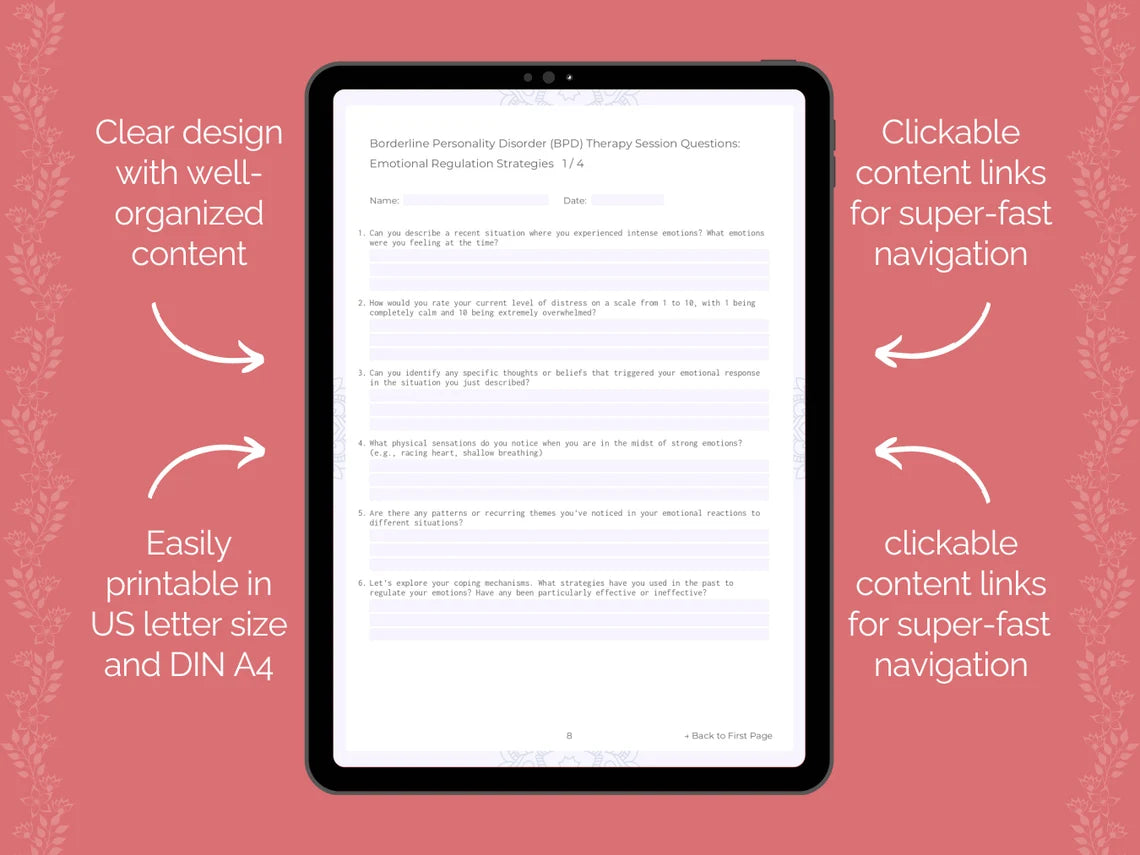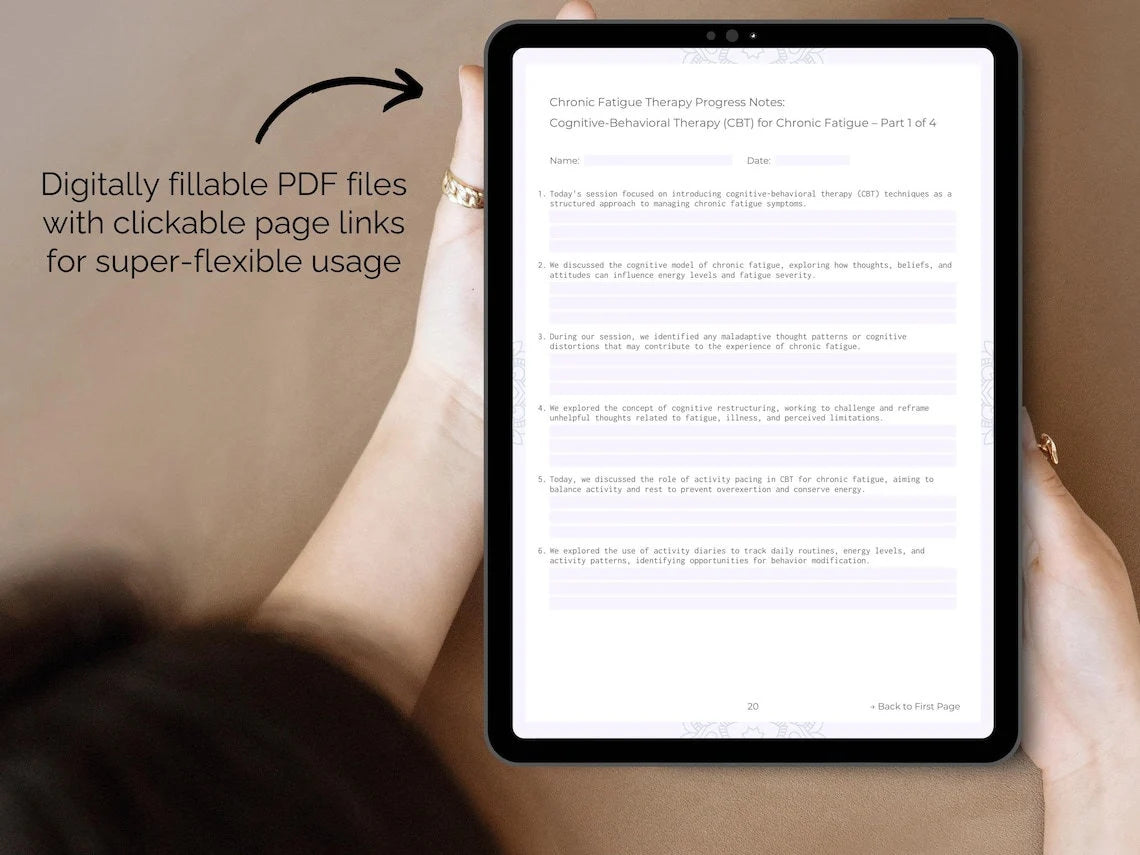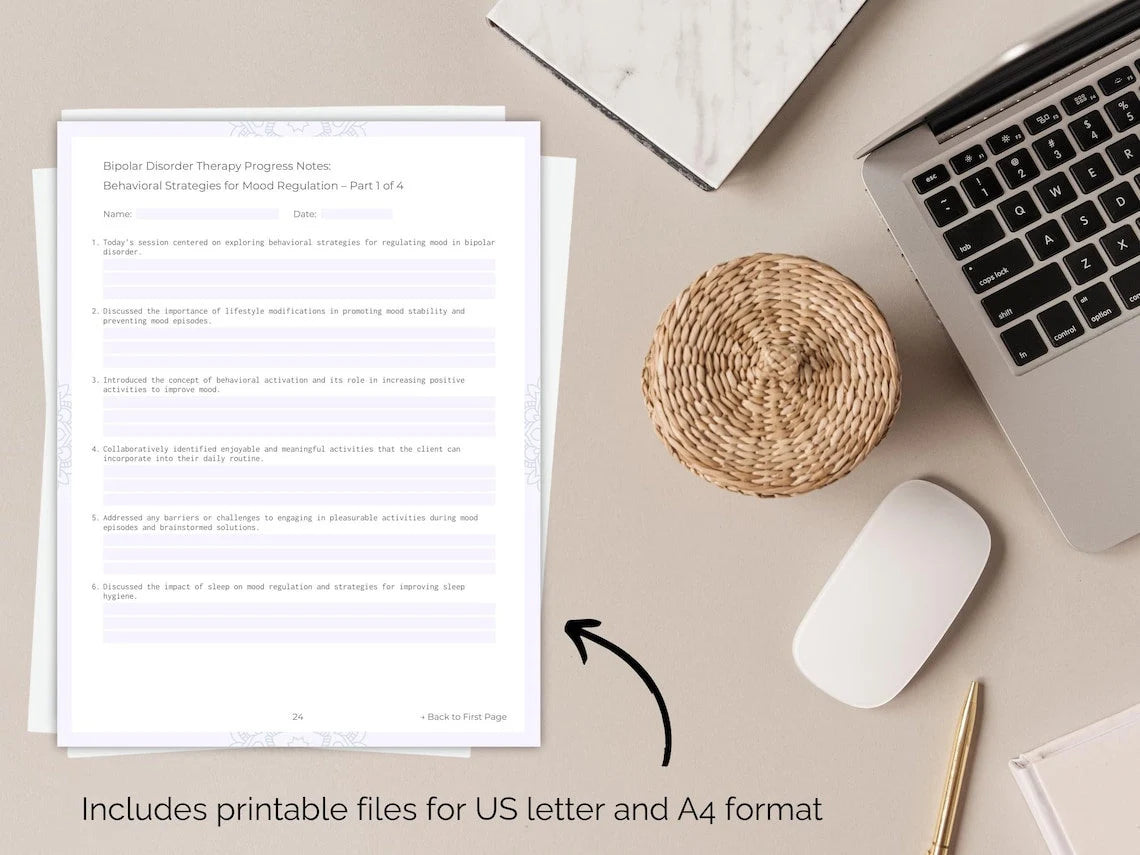Elevate Your Therapy and Guide Your Clients to Inner Healing with Our Loneliness Therapy Interventions! ✨
1. Beginning Our Work Together
- Let's start by establishing a safe and trusting therapeutic relationship where you feel comfortable expressing yourself freely.
- Explore the origins of your feelings of loneliness, including past experiences, relationships, and life transitions.
- Discuss your current social support system and the quality of your connections with others.
- Practice self-compassion and understanding as we delve into sensitive topics and emotions.
- Explore any fears or anxieties you may have about reaching out to others and forming new relationships.
- Engage in mindfulness exercises to help you stay present and connected to the moment.
- Challenge any negative self-talk or beliefs that perpetuate feelings of loneliness or inadequacy.
- Explore opportunities for social engagement, such as joining clubs, classes, or community groups.
- Practice self-care strategies to prioritize your physical, emotional, and mental well-being.
- Develop strategies for setting boundaries and prioritizing relationships that are mutually fulfilling.
- Learn to differentiate between healthy solitude and isolating loneliness.
Need more? Find all 500+ Therapy Interventions for Loneliness Therapy in our Digital Workbook!
2. Understanding Loneliness
- Let's explore the concept of loneliness together, understanding it as a complex emotional experience rather than simply the absence of company.
- Examine the potential causes of loneliness in your life, such as major life transitions, loss, or changes in relationships.
- Identify any underlying emotions that accompany your feelings of loneliness, such as sadness, fear, or shame.
- Discuss the difference between being alone and feeling lonely, recognizing that loneliness can occur even in the presence of others.
- Examine the role of attachment styles in shaping your relationships and susceptibility to loneliness.
- Reflect on the ways in which your environment, such as living situation or community, may impact your feelings of connection or isolation.
- Discuss the physiological effects of loneliness on your body and overall well-being, recognizing its impact on physical health.
- Identify any barriers you may face in seeking support or reaching out to others, such as stigma or fear of rejection.
- Consider the role of personality traits, such as introversion or extroversion, in shaping your experience of loneliness.
- Discuss coping mechanisms you may have developed to manage feelings of loneliness, recognizing both helpful and unhelpful strategies.
- Identify sources of social support in your life, such as friends, family, or community resources, to bolster your resilience.
Need more? Find all 500+ Therapy Interventions for Loneliness Therapy in our Digital Workbook!
3. Mindfulness for Connection
- Begin by introducing the concept of mindfulness as a tool for cultivating a deeper sense of connection with yourself and others.
- Explore the practice of mindful breathing as a way to regulate your emotions and reduce feelings of loneliness.
- Guide you through mindfulness-based stress reduction techniques to help alleviate the physiological effects of loneliness.
- Discuss the connection between mindfulness and emotional regulation, recognizing its potential to enhance your ability to cope with loneliness.
- Explore the concept of non-judgmental awareness in mindfulness practice, encouraging acceptance of your thoughts and emotions.
- Discuss the importance of present-moment awareness in building authentic connections with others.
- Introduce mindfulness exercises for enhancing communication skills, such as active listening and speaking from a place of authenticity.
- Discuss the connection between mindfulness and gratitude, encouraging you to cultivate appreciation for the relationships and connections in your life.
- Explore the concept of interconnectedness in mindfulness practice, recognizing that we are all part of a larger web of relationships.
- Discuss the role of mindfulness in building resilience to navigate through periods of loneliness with greater ease.
- Guide you through mindfulness exercises for setting boundaries and asserting your needs in relationships.
Need more? Find all 500+ Therapy Interventions for Loneliness Therapy in our Digital Workbook!
4. Dialectical Behavior Therapy (DBT) for Emotional Understanding
- Begin by introducing the principles of Dialectical Behavior Therapy (DBT) as a framework for developing emotional understanding and regulation skills.
- Discuss the importance of mindfulness as a foundational skill in DBT for observing and accepting your emotions without judgment.
- Explore the function of emotions and their role in communicating your needs and experiences to yourself and others.
- Introduce emotion regulation techniques to help you identify and label your emotions accurately, such as the "check the facts" skill to challenge assumptions.
- Introduce distress tolerance skills to help you cope with intense emotions without resorting to harmful or maladaptive behaviors.
- Explore the role of validation in DBT for acknowledging and accepting your emotions as valid and understandable responses to your experiences.
- Identify and challenge any black-and-white thinking or extreme beliefs you may hold about emotions, such as viewing certain emotions as "good" or "bad."
- Introduce self-soothing techniques to help you provide comfort and care to yourself during times of emotional distress.
- Identify and challenge any emotional avoidance strategies you may use to cope with difficult emotions, such as distraction or suppression.
- Introduce emotion exposure techniques to help you gradually confront and process difficult emotions in a safe and supportive environment.
- Explore the connection between emotional regulation and interpersonal effectiveness, recognizing how managing your emotions can enhance your relationships with others.
Need more? Find all 500+ Therapy Interventions for Loneliness Therapy in our Digital Workbook!
5. Interpersonal Therapy (IPT) for Enhancing Relationships
- Begin by introducing the principles of Interpersonal Therapy (IPT) as a framework for enhancing relationships and addressing feelings of loneliness.
- Identify specific interpersonal problems or conflicts that may be contributing to your experience of loneliness, such as difficulties in communication or unresolved conflicts with loved ones.
- Introduce the concept of the interpersonal inventory in IPT, which involves systematically assessing the quality and satisfaction of your relationships across various domains.
- Identify any maladaptive relationship patterns or coping strategies that may be perpetuating feelings of loneliness, such as excessive dependence on others or avoidance of intimacy.
- Introduce communication skills training to help you express your needs, emotions, and boundaries effectively in your relationships.
- Identify any interpersonal deficits or areas of difficulty that may be hindering your ability to form and maintain meaningful connections with others.
- Discuss the role of empathy and perspective-taking in fostering understanding and connection with others, even during times of disagreement or conflict.
- Identify and challenge any negative beliefs or assumptions you may hold about yourself or others in relationships that contribute to feelings of loneliness or inadequacy.
- Discuss the importance of reciprocity in relationships and explore ways to give and receive support from others in a balanced and mutually fulfilling manner.
- Introduce techniques for enhancing intimacy and emotional closeness in relationships, such as practicing active listening, vulnerability, and authenticity.
- Discuss the impact of cultural or societal factors on your relationships and explore ways to navigate cultural differences or norms in interpersonal interactions.
Need more? Find all 500+ Therapy Interventions for Loneliness Therapy in our Digital Workbook!
6. Emotion-Focused Therapy (EFT) for Emotional Loneliness
- Begin by introducing the principles of Emotion-Focused Therapy (EFT) as a framework for addressing emotional loneliness and cultivating emotional well-being.
- Identify and explore the specific emotions underlying feelings of loneliness, such as sadness, grief, fear, or shame, and validate their presence and significance.
- Discuss the role of emotional avoidance or suppression in perpetuating feelings of loneliness, and explore techniques for fostering emotional acceptance and expression.
- Identify any core emotional needs that may be unmet or underdeveloped, such as the need for comfort, validation, connection, or belonging, and explore ways to address these needs.
- Explore the concept of emotional regulation and distress tolerance in EFT, discussing techniques for managing overwhelming emotions and promoting emotional balance.
- Introduce emotion-focused imagery techniques to help you access and process underlying emotions, such as guided visualization or emotional imagery exercises.
- Explore the impact of self-criticism or negative self-talk on feelings of loneliness, and introduce techniques for cultivating self-compassionate and nurturing inner dialogue.
- Introduce techniques for building emotional resilience and coping with setbacks or challenges in relationships, fostering adaptability and self-efficacy.
- Introduce techniques for repairing or reworking past attachment wounds or relational ruptures that may contribute to feelings of emotional loneliness.
- Identify opportunities for building and strengthening emotional connections with others through shared experiences, vulnerability, and mutual support.
- Explore the concept of emotional differentiation and autonomy, promoting a healthy balance between emotional connection with others and self-sufficiency in managing emotions.
Need more? Find all 500+ Therapy Interventions for Loneliness Therapy in our Digital Workbook!
7. Delving into Relationship Dynamics
- Begin by establishing a supportive and nonjudgmental environment where the individual feels comfortable discussing their relationship dynamics.
- Use genograms or relationship timelines to visually map out the individual's significant relationships and any patterns or themes that emerge.
- Explore the individual's communication style and how it impacts their ability to connect with others, including assertiveness, active listening, and conflict resolution skills.
- Explore any fears or insecurities the individual may have about intimacy and vulnerability, helping them to develop strategies for building trust and connection with others.
- Encourage the individual to identify their relationship needs and preferences, helping them to communicate these effectively to others.
- Practice mindfulness exercises to help the individual become more present and attuned to their emotions and the dynamics within their relationships.
- Use art or expressive therapies such as drawing, writing, or role-playing to help the individual explore and express their feelings and experiences in relationships.
- Encourage the individual to engage in self-care activities that nurture their relationships, such as spending quality time together, expressing appreciation, and practicing forgiveness.
- Practice empathy exercises to help the individual understand and empathize with the perspectives of others in their relationships.
- Encourage the individual to seek support from trusted friends, family members, or support groups, particularly during times of difficulty or transition in their relationships.
- Use cognitive-behavioral techniques to challenge negative thought patterns and beliefs about relationships, helping the individual to develop more balanced and realistic perspectives.
Need more? Find all 500+ Therapy Interventions for Loneliness Therapy in our Digital Workbook!
8. Connecting through Music Therapy
- Begin by creating a comfortable and inviting space where the individual feels relaxed and open to exploring their emotions through music.
- Encourage the individual to listen to music that reflects their emotions and experiences, helping them to identify and connect with songs that resonate with them.
- Practice improvisation techniques, allowing the individual to freely express themselves through music without the pressure of pre-planned melodies or rhythms.
- Explore the individual's musical preferences and tastes, helping them to identify songs and genres that evoke particular emotions or memories for them.
- Use music listening exercises to help the individual regulate their emotions and shift their mood, whether they need to calm anxiety or boost their energy levels.
- Encourage the individual to explore the cultural and historical significance of music, helping them to connect with their heritage and identity through song.
- Practice guided relaxation techniques with live music accompaniment, allowing the individual to experience deep relaxation and inner peace through sound.
- Encourage the individual to create a personal soundtrack of their life, selecting songs that represent key moments and milestones in their journey.
- Explore the therapeutic benefits of singing, whether through group singing activities or solo vocalization exercises, helping the individual to express themselves vocally.
- Use music as a catalyst for creative expression, encouraging the individual to paint, write, or create other forms of art inspired by the music they listen to.
- Encourage the individual to attend live music performances or concerts as a way of connecting with others and experiencing the transformative power of music.
Need more? Find all 500+ Therapy Interventions for Loneliness Therapy in our Digital Workbook!
9. Reflecting on Progress
- Begin by inviting clients to reflect on their journey since starting therapy, encouraging them to consider both the challenges they've faced and the progress they've made.
- Prompt clients to identify specific goals they set at the beginning of therapy and to evaluate their progress toward achieving those goals.
- Provide a safe space for clients to express any feelings of frustration, disappointment, or uncertainty they may have about their progress.
- Encourage clients to celebrate their accomplishments, no matter how small, and to acknowledge their resilience in facing loneliness.
- Offer encouragement and reassurance to clients who may be feeling discouraged or unsure about their ability to overcome loneliness.
- Encourage clients to recognize the importance of self-care and self-compassion in their journey toward reducing loneliness.
- Use guided imagery or visualization exercises to help clients envision a future in which they feel more connected, supported, and fulfilled.
- Explore any shifts in clients' perspectives or attitudes toward loneliness, such as feeling less shame or stigma about their experiences.
- Use art therapy techniques, such as drawing or collage-making, as a creative way for clients to reflect on their progress and express their emotions.
- Collaborate with clients to identify any additional support or resources they may need to continue their progress outside of therapy.
- Validate clients' strengths and coping skills, highlighting moments when they have successfully navigated feelings of loneliness.
Need more? Find all 500+ Therapy Interventions for Loneliness Therapy in our Digital Workbook!
10. Moving Forward from Loneliness
- Start by exploring with clients their current understanding of loneliness and their readiness to move forward from it.
- Discuss the importance of setting realistic and achievable goals for combating loneliness in the future.
- Explore potential barriers to social connection, such as social anxiety or past relational traumas, and develop strategies for overcoming them.
- Offer guidance on how to identify and cultivate supportive relationships with friends, family members, or community groups.
- Explore opportunities for clients to volunteer or engage in acts of kindness and service as a way to connect with others and foster a sense of purpose.
- Encourage clients to practice assertive communication skills, including expressing their needs and setting boundaries in relationships.
- Offer guidance on how to navigate online communities and social media in a healthy and balanced way, minimizing feelings of comparison or inadequacy.
- Provide resources for clients to access professional support, such as support groups, counseling services, or helplines, if needed in the future.
- Offer strategies for managing and coping with feelings of loneliness when they arise, such as practicing self-soothing techniques or reaching out for support.
- Explore opportunities for clients to engage in meaningful activities or pursue goals that align with their interests and values.
- Discuss the importance of seeking professional help if feelings of loneliness become overwhelming or persistent, normalizing the process of reaching out for support.
We hope that our therapy interventions for Loneliness therapy will help you to elevate your therapy practice and guide your clients to inner healing! Do you need more therapy interventions for Loneliness therapy? Find them all in our Digital Workbook! Or do you have any questions or suggestions for us? Please feel free to contact us at any time!
